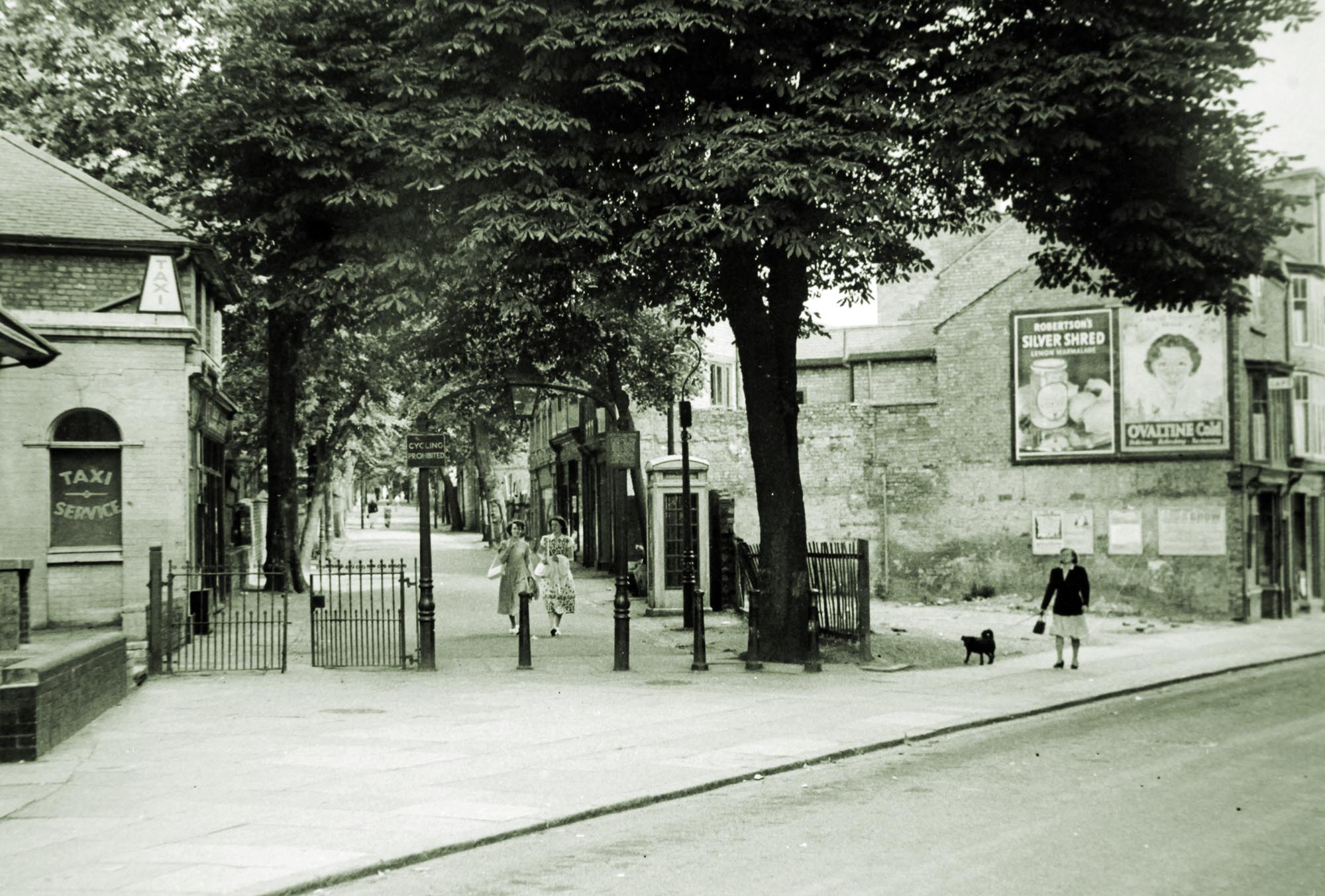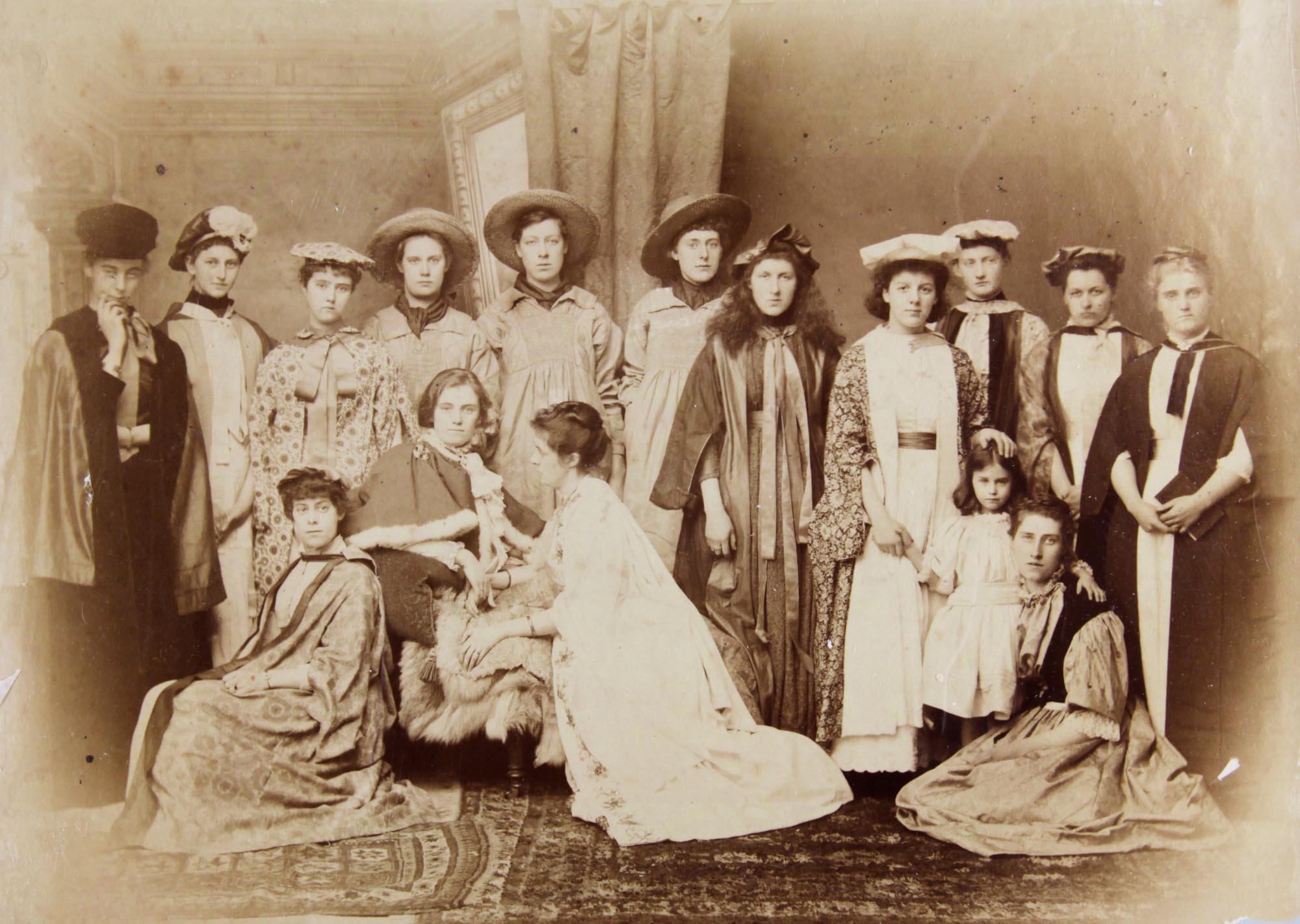- At first New Walk was called ‘Queen’s Walk’ after Queen Charlotte, wife of George III
- New Walk originally led to the horse racecourse which was replaced by Victoria Park in 1882
- The Victorian era public baths on New Walk were fed by a fresh water spring that’s 90 feet below the surface
Pedestrian promenade since 1785
New Walk is a rare example of a Georgian pedestrian promenade. Laid out by the Corporation of Leicester in 1785, the walkway was intended to connect Welford Place with the racecourse (now Victoria Park) and is said to follow the line of a Roman trackway, the Via Devana. Originally named “Queen’s Walk”, after Queen Charlotte, consort of George III, it was eventually the popular name of the “New Walk” that survived. Almost a mile long, New Walk has been a Conservation Area since 1969, ensuring its unique character is protected.
Living on New Walk
Houses built at the lower end of New Walk in the 1820s were the first on the walkway and were designed as “genteel residences” for the families and servants of businessmen and professionals. Development was controlled however to protect the public’s enjoyment of the walkway. Houses had to be at least ten yards from the Walk, fenced off by iron railings, and there was no access for carriages onto New Walk itself. In 1840 one resident described New Walk as “the only solely respectable street in Leicester”.
The houses around central New Walk date from the 1850s and 1860s and would have been the homes of merchants, manufacturers and professionals. Residents in the 1880s included Josiah Gimson, head of a large engineering firm, whose home (No. 112) is now part of the Belmont Hotel.
Last to be developed along New Walk were the large Victorian houses of its upper section (dating from the 1880s). Many were designed by the architect Stockdale Harrison. They reflect the growing prosperity of Leicester’s business and professional classes who preferred to live away from the town centre.

Public buildings and green spaces
The first public building on New Walk was a Roman Catholic chapel (1819) on the site of what is now Holy Cross Priory. A Nonconformist Proprietary School was opened in the 1830s and later became the Town Museum (now Leicester Museum & Art Gallery). The Albion Tepid Baths at 5 New Walk were built in the 1840s and used warm water provided by a sewing cotton factory at No 32 King Street.
Central New Walk contains two green spaces; The Oval (traditionally popular with children’s nannies) and De Montfort Square with its statue of Robert Hall, a 19th-century Baptist minister. Hall was a great public speaker who campaigned for better conditions for local hosiery workers. The Belmont Hotel building (on the corner of De Montfort Street) started life as a school for young ladies. Opposite is St Stephen’s United Reformed church, originally built on London Road near the railway station. It was moved here in the 1890s to make way for a hotel.
How has New Walk changed since 1785?
Most houses on New Walk were designed for large families with servants. By the later 19th Century, as family size fell, some became lodgings or apartments. More were sub-divided into offices or converted for educational use in the 20th Century, and by the 1970s New Walk had been transformed from a residential area into one dominated by commercial activities. Despite these changes it has managed to retain its unique character as an urban promenade.
Find out more about the history of New Walk by visiting the 'Friends of New Walk' website.
Gallery

Reproduced by kind permission of English Heritage

Leicestershire Record Office

Leicestershire Record Office

Leicestershire Record Office




Leicestershire Record Office


Leicestershire Record Office
Roman Leicester
(47- 500) A military fort was erected, attracting traders and a growing civilian community to Leicester (known as Ratae Corieltauvorum to the Romans). The town steadily grew throughout the reign of the Romans.
Medieval Leicester
(500 – 1500) The early years of this period was one of unrest with Saxon, Danes and Norman invaders having their influences over the town. Later, of course, came Richard III and the final battle of the Wars of the Roses was fought on Leicester’s doorstep.
-
The Castle Motte1068

-
Leicester Cathedral1086

-
St Mary de Castro1107

-
Leicester Abbey1138

-
Leicester Castle1150

-
Grey Friars1231

-
The Streets of Medieval Leicester1265

-
Leicester Market1298

-
Trinity Hospital and Chapel1330

-
Bow Bridgecirca 1350

-
Church of the Annunciation1353

-
John O’Gaunt’s Cellar1361

-
St John's Stone1381

-
Leicester Guildhall1390

-
The Magazine1400

-
The Blue Boar Inn1400

-
The High Cross1577

Tudor & Stuart Leicester
(1500 – 1700) The wool trade flourished in Leicester with one local, a former mayor named William Wigston, making his fortune. During the English Civil War a bloody battle was fought as the forces of King Charles I laid siege to the town.
Georgian Leicester
(1700 – 1837) The knitting industry had really stared to take hold and Leicester was fast becoming the main centre of hosiery manufacture in Britain. This new prosperity was reflected throughout the town with broader, paved streets lined with elegant brick buildings and genteel residences.
-
Great Meeting Unitarian Chapel1708

-
The Globe1720

-
17 Friar Lane1759

-
Black Annis and Dane Hills1764

-
Leicester Royal Infirmary1771

-
New Walk1785

-
Freemasons’ Hall1790

-
Gaols in the City1791

-
Friars Mill1794

-
City Rooms1800

-
Development of Highfields1800

-
Wesleyan Chapel1815

-
20 Glebe Street1820

-
Charles Street Baptist Chapel1830

-
Glenfield Tunnel1832

-
James Cook1832

Victorian Leicester
(1837 – 1901) The industrial revolution had a huge effect on Leicester resulting in the population growing from 40,000 to 212,000 during this period. Many of Leicester's most iconic buildings were erected during this time as wealthy Victorians made their mark on the town.
-
Leicester Union Workhouse1839

-
Campbell Street and London Road Railway Stations1840

-
The Vulcan Works1842

-
Belvoir Street Chapel1845

-
Welford Road Cemetery1849

-
Leicester Museum & Art Gallery1849

-
King Street1850

-
Cook’s Temperance Hall & Hotel1853

-
Amos Sherriff1856

-
Weighbridge Toll Collector’s House1860

-
4 Belmont Villas1862

-
Top Hat Terrace1864

-
Corah and Sons - St Margaret's Works1865

-
Kirby & West Dairy1865

-
The Clock Tower1868

-
Wimbledon Works1870

-
The Leicestershire Banking Company1871

-
St Mark’s Church and School1872

-
Victorian Turkish Baths1872

-
The Town Hall1876

-
Central Fire Stations1876

-
Aylestone Road Gas Works and Gas Museum1879

-
Gas Workers Cottages1879

-
Leicestershire County Cricket Club1879

-
Welford Road Tigers Rugby Club1880

-
Secular Hall1881

-
Development of Highfields1800

-
Abbey Park1881

-
Abbey Park Buildings1881

-
Victoria Park and Lutyens War Memorial1883

-
Leicester Fosse FC 18841884

-
Leicester Coffee and Cocoa Company Coffee Houses1885

-
St Barnabas Church and Vicarage1886

-
Abbey Pumping Station1891

-
Luke Turner & Co. Ltd.1893

-
West Bridge Station1893

-
Thomas Cook Building1894

-
The White House1896

-
Alexandra House1897

-
Leicester Boys Club1897

-
Grand Hotel and General Newsroom1898

-
Highfield Street Synagogue1898

-
Western Park1899

-
Asfordby Street Police Station1899

-
Leicester Central Railway Station1899

Edwardian Leicester
(1901 – 1910) Electric trams came to the streets of Leicester and increased literacy among the citizens led to many becoming politicised. The famous 1905 ‘March of the Unemployed to London’ left from Leicester market when 30,000 people came to witness the historic event.
-
YMCA Building1900

-
The Palace Theatre1901

-
Pares's Bank1901

-
Coronation Buildings1902

-
Halfords1902

-
High Street1904

-
George Biddles and Leicester's Boxing Heritage1904

-
Municipal Library1905

-
Leicester Boys Club1897

-
The Marquis Wellington1907

-
Guild Hall Colton Street1909

-
Women's Social and Political Union Shop1910

-
Turkey Café1901

Early 20th Century Leicester
(1910 – 1973) The diverse industrial base meant Leicester was able to cope with the economic challenges of the 1920s and 1930s. New light engineering businesses, such as typewriter and scientific instrument making, complemented the more traditional industries of hosiery and footwear manufacturing.
-
Dryad Handicrafts1912

-
De Montfort Hall1913

-
Leicester During the First World War1914

-
Fox’s Glacier Mints1918

-
Statue of Liberty1919

-
Housing in Saffron Lane1924

-
Winstanley House1925

-
Housing in North Braunstone1926

-
Lancaster Road Fire Station1927

-
The Little Theatre1930

-
Saffron Hill Cemetery1931

-
Braunstone Hall Junior School1932

-
Former City Police Headquarters1933

-
Savoy Cinema1937

-
Eliane Sophie Plewman1937
-
City Hall1938

-
Athena - The Odeon Cinema1938

-
The Blitz in Highfields1940

-
Freeman, Hardy and Willis - Leicester Blitz1940

-
Leicester Airport1942

-
Leicester’s Windrush Generations1948

-
Netherhall Estate1950
-
Housing at Eyres Monsell1951

-
Silver Street and The Lanes1960

-
Bostik1960

-
Auto-Magic Car Park (Lee Circle)1961

-
University of Leicester Engineering Building1963

-
Sue Townsend Theatre1963

-
Central Mosque1968

-
Belgrave Flyover1973

Modern Leicester
(1973 – present day) Industry was still thriving in the city during the 1970s, with the work opportunities attracting many immigrants from all over the world. While industry has declined in recent years, excellent transport links have made Leicester an attractive centre for many businesses. The City now has much to be proud of including its sporting achievements and the richness of its cultural heritage and diversity.
-
Haymarket Theatre1973

-
The Golden Mile1974

-
Acting Up Against AIDS1976

-
Belgrave Neighbourhood Centre1977

-
Diwali in Leicester1983

-
Leicester Caribbean Carnival1985

-
Samworth Brothers1986

-
Jain Centre1988

-
Guru Nanak Dev Ji Gurdwara1989

-
King Power Stadium2002

-
LCB Depot2004

-
Curve2008

-
BAPS Shri Swaminarayan Mandir2011

-
Makers Yard2012

-
VJ Day 80th Anniversary2020

- Roman Leicester
- Medieval Leicester
- Tudor & Stuart Leicester
- Georgian Leicester
- Victorian Leicester
- Edwardian Leicester
- Early 20th Century Leicester
- Modern Leicester
A Place to Live
















































































































































